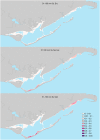The influence of freshwater inflow and seascape context on occurrence of juvenile spotted seatrout Cynoscion nebulosus across a temperate estuary
- PMID: 38015854
- PMCID: PMC10684023
- DOI: 10.1371/journal.pone.0294178
The influence of freshwater inflow and seascape context on occurrence of juvenile spotted seatrout Cynoscion nebulosus across a temperate estuary
Erratum in
-
Correction: The influence of freshwater inflow and seascape context on occurrence of juvenile spotted seatrout Cynoscion nebulosus across a temperate estuary.PLoS One. 2024 Feb 15;19(2):e0299241. doi: 10.1371/journal.pone.0299241. eCollection 2024. PLoS One. 2024. PMID: 38359062 Free PMC article.
Abstract
Spotted seatrout, a popular recreational sport fish in the southeastern United States, are affected by freshwater flow conditions and the availability of estuarine habitat. However, the relative influence of these factors, particularly on early life stages of seatrout, remains uncertain. We used generalized linear models to quantify relationships between the probability of encountering juvenile spotted seatrout during seine surveys and various factors, including freshwater inflow conditions, the availability and richness of estuarine habitats (seagrass, salt marsh, oyster beds) around (400-m radius) fish collection sites (seascape-scale context), as well as distance to the nearest inlet to the Gulf of Mexico (estuary-scale context) across shallow waters (< 1.5 m depth) of Apalachicola Bay, Florida. Modelling results showed a consistent positive correlation between seagrass area and the probability of encountering juvenile seatrout (all four size classes from 15mm-200mm Standard Length (SL)). The probability of encountering the two smallest juvenile seatrout size classes (15-50mm and 51-100mm SL) was also related to freshwater inflow conditions, particularly within a 3-month period prior to and including peak recruitment. Freshwater inflow may affect early life stages by influencing passive transport of eggs and larvae, planktonic food availability, and predation pressure through increases in turbidity. In contrast, encounter probabilities of the two larger size classes (101-150mm and 151-200mm) were unrelated to freshwater inflow. Inflow-related processes may be less important to the larger juveniles as they have typically settled out of the plankton into benthic habitats which provide refuge from predation and abundant benthic food sources which are not as closely tied to freshwater inflow effects. In addition, models revealed that occurrence of the larger juveniles was related to the availability of nearby habitat types such as oyster beds and salt marshes, suggesting that increased mobility as seatrout grow may allow them to use nearby habitat types as additional sources of food and refuge. These results add to a growing body of literature aimed at understanding the influence of freshwater inflow as well as seascape context on vulnerable juvenile life stages of fishery species to provide more informed strategies for freshwater inflow management and habitat conservation.
Copyright: © 2023 Whaley et al. This is an open access article distributed under the terms of the Creative Commons Attribution License, which permits unrestricted use, distribution, and reproduction in any medium, provided the original author and source are credited.
Conflict of interest statement
The authors have declared that no competing interests exist.
Figures
References
-
- Broadley A, Stewart-Koster B, Burford MA, Brown CJ. A global review of the critical link between river flows and productivity in marine fisheries. Reviews in Fish Biology and Fisheries. 2022. Sep;32(3):805–25.
-
- Robins JB, Halliday IA, Staunton-Smith J, Mayer DG, Sellin MJ. Freshwater-flow requirements of estuarine fisheries in tropical Australia: a review of the state of knowledge and application of a suggested approach. Marine and Freshwater Research. 2005. Jun 3;56(3):343–60.
-
- Gillson J. Freshwater flow and fisheries production in estuarine and coastal systems: where a drop of rain is not lost. Reviews in Fisheries Science. 2011. Jul 1;19(3):168–86.
-
- Beck MW, Heck KL, Able KW, Childers DL, Eggleston DB, Gillanders BM, et al. The identification, conservation, and management of estuarine and marine nurseries for fish and invertebrates: a better understanding of the habitats that serve as nurseries for marine species and the factors that create site-specific variability in nursery quality will improve conservation and management of these areas. Bioscience. 2001. Aug 1;51(8):633–41.
-
- Sheaves M, Baker R, Nagelkerken I, Connolly RM. True value of estuarine and coastal nurseries for fish: incorporating complexity and dynamics. Estuaries and Coasts. 2015. Mar;38:401–14.
MeSH terms
LinkOut - more resources
Full Text Sources









